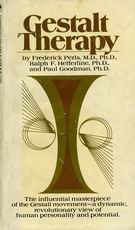
Gestalt Therapy
Excitement and Growth in the Human Personality
Perls, Frederick; Hefferline, Ralph E. Goodman, Paul
Publisher: Dell Publishing Co., Inc., USA
Year Published: 1951
Pages: 470pp Dewey: 150.1982
Resource Type: Book
Cx Number: CX8344
The authors believe that the Gestalt outlook is the original, undistorted, natural approach to life, to thinking, acting and feeling.
Abstract:
-
Table of Contents
Volume One
Introduction
Part One: Orienting the Self
1. The Starting Situation
2. Contacting the Environment
Experiment 1: Feeling the Actual
Experiment 2: Sensing Opposed Forces
Experiment 3: Attending and Concentrating
Experiment 4: Differentiating and Unifying
3. Technique of Awareness
Experiment 5: Remembering
Experiment 6: Sharpening the Body-Sense
Experiment 7: Experiencing the Continuity of Emotion
Experiment 8: Verbalizing
Experiment 9: Integrating Awareness
4. Directed Awareness
Experiment 10: Converting Confluence into Contact
Experiment 11: Changing Anxiety into Excitement
Part Two: Manipulating the Self
5. The Modified Situation
6. Retroflection
Experiment 12: Investigating Misdirected Behavior
Experiment 13: Mobilizing the Muscles
Experiment 14: Executing the Re-reversed Act
7. Introjection
Experiment 15: Introjecting and Eating
Experiment 16: Dislodging and Digesting Introjects
8. Projections
Experiment 17: Discovering Projections
Experiment 18: Assimilating Projections
Index
Volume Two
Part One: Introduction
1. The Structure of Growth
2. Differences in General Outlook and Differences in Therapy
Part Two: Reality, Human Nature, and Society
3. "Mind," "Body," and "External World"
4. Reality, Emergency, and Evaluation
5. Maturing, and the Recollection of Childhood
6. Human Nature and the Anthropology of Neurosis
7. Verbalizing and Poetry
8. The Anti-Social and Aggression
9. Conflict and Self-Conquest
Part 3: Theory of the Self
10. Self, Ego, Id, and Personality
11. Critique of Psychoanalytic Theories of the Self
12. Creative Adjustment, I: Fore-Contact and Contacting
13. Creative Adjustment, II: Final Contact and Post-Contact
14. Loss of Ego-Functions, I: Repression, Critique of Freud's Theory
15. Loss of Ego-Functions, II: Typical Structures and Boundaries
Subject Headings


